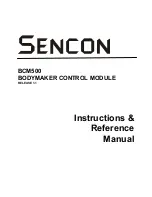
©
2012 Sencon Incorporated
Page 11
BCM500/387 Bodymaker System
POWER UP
The 387 sensor must be calibrated to the punch before operation. If the first two digits of the sensor serial
number are
"
71' or higher, then the sensor saves the calibration information in non-volatile EEPROM. A CAL
output 100 milliseconds after power up indicates the sensor has calibration information stored in EEPROM
Earlier model sensors do not save calibration information and must be calibrated every time the unit powers
up.
The calibration is achieved by cycling the machine at least four times with the CAL input set and without cans
in process. This must be done at low speed or in Single Stroke mode. These four cycles allow the sensor to
calibrate to the punch material and to profile the punch within the timing window. Subsequent starting and
stopping of the machine will not affect the calibration.
The CAL output will turn on once the sensor has successfully calibrated itself to the punch. This signal will
remain on while cans are in process. The CAL input must go inactive after the CAL output turns on and
before the cup feed turns on. Recalibration can be done by periodically interrupting the cup feed and setting
the CAL input on for at least four machine cycles.
The BCM500 must receive a RES input or a CAL input after power up. Otherwise, the unit will not engage any
of the clutch outputs.
WINDOW AND CALIBRATE SIGNAL TIMING
The diagram below describes the relationship between the SCT signal, the CAL signal, and the position of the
carbide punch. The SCT signal becomes active sometime after the nosepiece of the punch has passed the
sensor, and remains active until the trimline is reached. The CAL signal must be active a minimum of 40
degrees before the leading edge of the SCT signal.




















